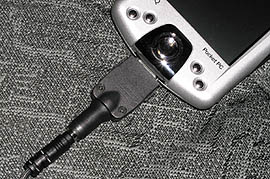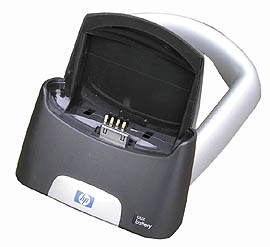Hewlett Packard iPAQ 2215 Pocket PC
The Mighty Mouse of Pocket PCs
Shingle Springs, CA, June 24, 2003 -- HP seems determined to cement its position as the undisputed leader in the Pocket PC arena. Late last year handheld enthusiasts were treated to the powerful h5450 with an integrated 802.11b radio and the diminutive h1900 that quickly became a favorite in our office due to its great display, impossibly small size, and terminal cuteness. Even our intrepid Palm editor Shawn Barnett took to the little iPAQ and carried it around in addition to the half dozen Palms and Sonys he usually has in his pockets. Just over half a year later Hewlett Packard strikes again with yet another double salvo, introducing the iPAQ h2200 and h5500 Series.

Not just a beefed-up h1900
At first sight you'd think the h2200 (the actual model name is h2215 for the retail version and h2210 for the commercial version) is simply a beefed up h1900 but that impression is wrong. Placed side by side, it quickly becomes obvious that these are two very different devices. Both are small and sleek, but they differ significantly in design, materials, execution and features. Compared to the original iPAQ (which was considered very small when it was introduced), both are considerably more compact. The h2200 has a footprint of 3 x 4.5 inches and is 0.6 inches thick, compared to the h1900's 2.75 x 4.46 x 0.5 inches. The h2200 weighs 5.1 ounces compared to the little h1900's 4.25. And they really don't look anything alike. Whereas the h1900 was a gleaming little marvel with a shiny metallic housing and Sonyesque design and execution, the h2200 looks more like a conventional PDA. The four frontal function buttons are placed iPAQ-style to the left and right of a chrome navigation disc. The body is made of plastic with a metallic powdery finish. The left and right side have black rubber inserts for a better grip, just like the long departed Philips Nino once had. The top features iPAQ-style shiny black plastic. The h2200 is the first Pocket PC that completely foregos the rocker and recording button on the left side and we don't miss them. The display is small, 3.5 inches diagonal as opposed to the 3.8-inch LCDs of the "full-size" iPAQs, but those wouldn't fit in a package this compact. There isn't a screen lid or anything else to protect the display, but HP ships the device with a basic but well designed canvas case.
Chock full of power
What's amazing is the amount of power HP managed to pack into this new little device. The original h1900's 200MHz PXA250 processor is old hat compared to the powerhouse sitting under the tiny hood of the h2200, an Intel PXA255 chip that has twice the internal bus speed and runs at 400MHz to boot. There is 64MB of RAM of which 57 is available to the user (as opposed to just 47 in the h1900). The h2200 also justifies its slightly larger size with the inclusion of a full Type II CF Card slot in addition to the MMC/SD card slot. The slots are sitting side by side on top of the device, the SD slot small enough as to not require a special cover whereas the CF slot houses a black plastic dummy if you do not use a card in it. What's even better is that the SD slot is of the SDIO variety, which means it can accommodate more than just memory cards. As soon as they become available you'll be able to pop in a SD wireless LAN card and still have the CF slot available for other purposes. As someone who often listens to music stored on my iPAQ via my Sony noise-canceling headphones, I really appreciate the standard 3.5mm audio jack instead of the h1900's 2.5mm mini jack. Yes, there are adapters, but the fewer of them I need to carry around the better.
Performance bottleneck resolved?
Since the h2200 has both a fast PXA255 processor AND Windows Mobile 2003 that supposedly takes much better advantage of the features of Intel's new Xscale architecture, everyone will want to know about performance. Unfortunately, the current version of VOBenchmark does not work on the h2200. The German Pocket PC Benchmark also did not run, requesting embedded Visual Basic runtime to work. With no benchmarks working we did a more informal test, loading a large 1 megabyte Word file and scrolling through it in maximum speed. The h2200 did it in 1:30 minutes, a review Toshiba e755 which also has a PXA255 and an excellent graphics subsystem, but ran the old PPC 2002, took 1:40 minutes. My old Compaq 3670 did it in 1:45. Interestingly, though, on the old iPAQ, the file only required 383k of storage. When I copied the file from the old iPAQ to the new one, it remained at its smaller size. Apparently, somehow converting via ActiveSync 3.7 onto a Windows Mobile 2003 machine resulted in a much larger file.
 But that's not all. The h2200 also comes standard with Zeevo system-on-chip Bluetooth. This makes it an instant full member of the growing Bluetooth community where you can access the Internet via a Bluetooth enabled phone, print to a printer with a Bluetooth interface, exchange business cards, synchronize wirelessly (and much faster than via IR), and just generally do stuff without a bunch of extra cables. With this, the h2200 is still a bit ahead of the curve as Bluetooth is still far from ubiquitous, but having Bluetooth is definitely better than not having it. Theoretically, the Bluetooth possibilities are almost endless. What will actually come to pass no one knows. But that's not all. The h2200 also comes standard with Zeevo system-on-chip Bluetooth. This makes it an instant full member of the growing Bluetooth community where you can access the Internet via a Bluetooth enabled phone, print to a printer with a Bluetooth interface, exchange business cards, synchronize wirelessly (and much faster than via IR), and just generally do stuff without a bunch of extra cables. With this, the h2200 is still a bit ahead of the curve as Bluetooth is still far from ubiquitous, but having Bluetooth is definitely better than not having it. Theoretically, the Bluetooth possibilities are almost endless. What will actually come to pass no one knows.
On the display side, the news is generally good. The 3.5-inch transflective display (0.24 mm dot pitch) is bright and contrasty indoors, easily readable in direct sunlight, and has none of the annoying sidelight glare of earlier reflective screens. However, side by side with the h1900, it cannot match the smaller device's world-class display. It is not quite as bright and has less contrast. It is still very good, just not as good as the one on the h1900.
Cradle, power, and new OS
The h2200 comes with a cradle whose design follows that of all other recent iPAQ cradles: dark gray plastic in the front with a silvery stand. There is no extra room for a sleeve because the h2200 doesn't have one. The h2200 is much smaller than the "standard" iPAQs and none of the old sleeves work with it. The cradle does, however, have room for a spare battery that can be charged. Also like most recent iPAQs, the h2200 has sort of an interesting power connection arrangement. The device itself does not have a power jack, which means that you must use a small black converter as a go-between from the power cable to the docking connector of the PDA. I've never been partial to this design, but as long as HP will permanently attach the converter dongle to the power cable so it can't be lost, I'm okay with it. The power prongs themselves are on the power brick which means plugging it in will take two or three spots on a power strip. The power cable is six feet long, just about the minimum I find acceptable.
 In terms of software functionality, the h2200 was the first device we reviewed to run an early version of Windows Mobile 2003 for Pocket PC, Microsoft's operating system/application suite for Pocket PCs. At first sight, Windows Mobile 2003 looks and feels almost exactly the same as Pocket PC 2002, with most changes apparently being either bug fixes or rewriting of code to take better advantage of the now universally used Xscale processor architecture. One obvious difference was the ever-popular (not!) Connections screen which, unfortunately, remains nearly as befuddling as the old one, and just as singlemindedly convinced that you will want to use a modem as the older rev. In fairness, Windows Mobile 2003, though it looks nearly unchanged, is a much better platform than the one it replaces. It is based on CE .NET 4.2 instead of the old Windows CE 3.0, and it offers very significant advancements in stability, security, and facilities to make it a more powerful part of corporate systems and the overall .NET strategy. As stated in our news item on the Pen Computing front page, Windows Mobile 2003 may not be all we wanted or expected, but it sure is what we needed.
Lots of software
The software on the h2200 itself is good news. In addition to the standard Pocket PC fare that now includes version 9.0 of the Windows Media Player, HP adds the nifty Nevo universal remote control, a good Bluetooth Manager, the iPAQ Image Viewer, the iTask program picker, and a variety of optional software on the CD that comes with the device.
The CD-ROM includes ActiveSync 3.7 which is required for the h2200. You can also install AvantGo, a free 10-seat license for Xcellenet's Afaria mobile infrastructure solution, a 60-day trial of the Cadenza mNotes Lotus note synchronization product, Westtek's ClearVue Office that lets you view Office documents in native form, Peacemaker Professional 1.25, Margi System's Presenter-to-Go, iPresentation Mobile Converter LE, Adobe Acrobate Reader for Pocket PC 1.0, a trial version of Ilium Software's eWallet Professional and ListPro, F-Secure FileCrypto for Pocket PC Personal Edition, and Conduits' Pocket Watch, the Interactive World Clock for Pocket PC. There are also links to Handango's site with trial offers for more Pocket PC software. All in all plenty to keep most users happy. I should also mention a new ClearType tuner utility that has a slider to get the best subjective viewing quality, a Certificates applet, and the always handy Asset Viewer. Finally, there is a fine iPAQ Audio panel that lets you adjust bass boost and treble as well as microphone gain.
Replaceable power pack
After experimentation with internal Lithium-Polymer batteries in earlier iPAQs, HP has now returned to standard replaceable Li-Ion battery packs. The one in the h2200 is very small, but packs 900 mAH and HP claims battery life up to 12 hours. Ours came quite close to that. The device also has a Li-Ion backup battery and a pretty elaborate power management control panel application that shows you how many hours of life is left if you wish to have anywhere between 24 and 96 hours of standby power. Be warned though: even a fully charged backup battery will discharge quickly if you take out the main battery.
Back it up
I've always liked the iPAQ's backup/restore utility because it includes an automatic scheduling feature that does the backups even when I forget to do them. One problem I ran into is that the internal iPAQ File Store is quite small, only six MB or so, and I was unable to do a backup without using a memory card.
A lot of Pocket PC for the money
As far as price point goes, you are looking at US$399 list. That's considerably less than the "big" iPAQs, but a hundred dollars above the h1900. For 50 dollars less you can get a Toshiba 330/335 which doesn't have the transflective display, the CF card slot or Bluetooth. The Dell Axim cost less and is a terrific value, but it is considerably bigger and heavier. On the Palm side you might be considering a Tungsten T which does have Bluetooth and a higher resolution display (320 x 320), but just 16MB of RAM and it's, ummm, just a Palm.
A hearty thumbs-up!
So all in all we give the new iPAQ h2200 a hearty thumbs-up. It packs a lot of power and features into a small and handy package. We're not talking grand design revolution this time, just a well designed and well executed compact little Pocket PC that does just about everything right. After a week with the new iPAQ h2200 you don't know how you ever did without it.
– Conrad H. Blickenstorfer
| Processor |
Intel XScale PXA255, 400 MHz |
| OS |
Windows Mobile 2003 |
| Memory |
64MB RAM, 32MB Flash ROM |
| Display |
64k color 240 x 320 pixel transflective TFT LCD |
| Digitizer |
Pressure-sensitive panel |
| Storage |
Internal RAM, CF extended Type II, SD/MMC SDIO |
| Size |
3.0 x 4.54 x 0.61 inches |
| Weight |
5.1 oz |
| Power |
Replaceable Li-Ion ("up to 12 hours") |
| Interface |
USB, Bluetooth, IrDA, stereo audio, mic |
| Options |
CF and SD cards, foldable keyboard, wireless |
| Price |
US$399 |
| Contact |
Hewlett Packard www.hp.com/ |
|



 But that's not all. The h2200 also comes standard with Zeevo system-on-chip Bluetooth. This makes it an instant full member of the growing Bluetooth community where you can access the Internet via a Bluetooth enabled phone, print to a printer with a Bluetooth interface, exchange business cards, synchronize wirelessly (and much faster than via IR), and just generally do stuff without a bunch of extra cables. With this, the h2200 is still a bit ahead of the curve as Bluetooth is still far from ubiquitous, but having Bluetooth is definitely better than not having it. Theoretically, the Bluetooth possibilities are almost endless. What will actually come to pass no one knows.
But that's not all. The h2200 also comes standard with Zeevo system-on-chip Bluetooth. This makes it an instant full member of the growing Bluetooth community where you can access the Internet via a Bluetooth enabled phone, print to a printer with a Bluetooth interface, exchange business cards, synchronize wirelessly (and much faster than via IR), and just generally do stuff without a bunch of extra cables. With this, the h2200 is still a bit ahead of the curve as Bluetooth is still far from ubiquitous, but having Bluetooth is definitely better than not having it. Theoretically, the Bluetooth possibilities are almost endless. What will actually come to pass no one knows.
